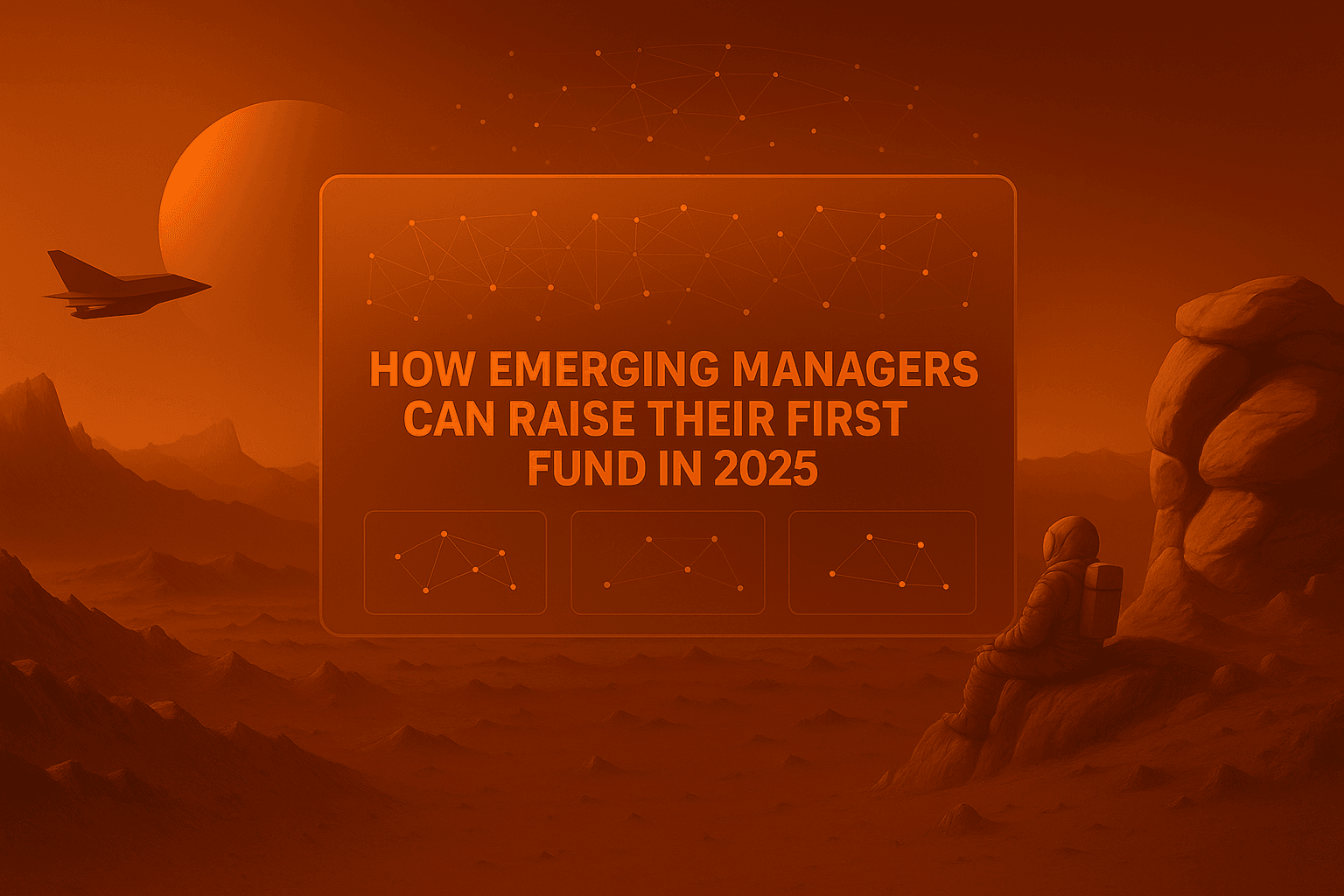How to Choose a Family Office Database for Fundraising in 2026
A buyer’s guide for Fund I–III managers and IR teams in the US and Europe choosing a family office database—how to evaluate coverage, update cadence, data quality, and workflow fit, plus what “good” looks like in 2026 if you are serious about raising from family offices.

How to Choose a Family Office Database for Fundraising in 2026
1. Why family office databases matter more in 2026 than they did in 2016
Ten years ago, many GPs still assumed that a handful of conferences and warm intros would be enough to fill a fund. In 2026, that’s no longer realistic—especially for first- and second-time managers in the US and Europe.
Three structural shifts make family office intelligence genuinely strategic:
Family offices now anchor a large share of emerging managers.
Large institutions want multi-fund track records. Family offices and entrepreneurs are more willing to underwrite conviction strategies and niche funds—if they can understand your edge and see a fit with their mandate.
New wealth is more fragmented and moves faster.
Single exits in software, fintech, crypto, or real assets can create entirely new UHNW families. Many of them operate outside traditional institutional frameworks for years before appearing in “classic” LP databases.
The GP/LP discovery process is multi-channel.
LinkedIn, events, mutual intros, newsletters, and founder networks all matter. But to run a disciplined process, you still need a central system that tells you: who is this, what do they care about, and how do I reach them compliantly?
That’s where family office databases come in. The real challenge in 2026 isn’t “should I use one?”, but “which type is built for the kind of fundraising I’m actually doing?”
2. Start with your real use case (not with features)
Before you compare platforms, write down in plain language what you’re trying to accomplish over the next 24 months.
Some examples:
- US or European Fund I VC (e.g. $40–80m)
You need deep coverage of single and multi-family offices that back emerging managers, plus practical contact data for decision-makers. - Growth / pre-IPO or private credit strategy
You care about larger multi-family offices, cross-over investors, and allocators with appetite for non-venture risk. - Direct deal/co-invest platform
You want to know which families consistently co-invest, their typical ticket sizes, and how quickly they move.
This leads to real trade-offs:
- Depth vs breadth: Is it more important to have the best possible coverage of family offices, or “everyone” including RIAs, wealth managers, and pensions?
- Signal vs static: Is it enough to know a family office exists, or do you need up-to-date signals on mandates and activity?
- Price vs value: Are you optimizing for the cheapest line item, or the database that gives you the highest likelihood of closing the fund?
Once you’re honest about your use case, the platform selection becomes far simpler.
3. The eight dimensions that actually matter
Most marketing pages talk about record counts and filters. Helpful, but superficial. If you are a serious GP or IR lead, here is what you actually care about.
3.1 Coverage and focus
Start with the basics, but go deeper than “we have X family offices”:
- How many family offices are covered globally?
- How are they distributed across US, Europe, and the rest of the world?
- What is the split between single and multi-family offices?
- Does the platform also include RIAs, wealth managers, pensions, etc.—and do you want that, or will it dilute your efforts?
Some platforms are essentially private-wealth databases that include family offices as one segment among many. That can be powerful if you sell into advisors and intermediaries, but less focused if your real edge is direct relationships with principals.
Altss intentionally takes the other route: it is built around family offices as the core object, with more than 9,000 family offices globally, and particularly deep coverage in the US and Europe.
3.2 Update cadence and methodology
A database that updates once a year is not an intelligence product; it’s a directory.
Questions to ask:
- What is the full refresh frequency on the family office universe?
- Is the data sourced once, then passed from user to user—or is there an ongoing combination of OSINT, vendor feeds, and manual QA?
- Can the provider show you how often mandates, contacts, and deal histories are updated in practice?
In 2026, a serious allocator database should be able to talk concretely about its update cycle, not just say “updated regularly.”
Altss is structured around a 30-day update cadence for core fields, powered by OSINT pipelines, third-party verification, and human checks. That’s the level you should expect from any provider that claims to do allocator intelligence, not just basic lists.
3.3 Depth of each profile
Coverage is the top of the funnel. Depth is what determines whether your team actually gets value from the product.
Look for:
- Firm-level data: geography, structures, investment themes, approximate AUM if disclosed, asset-class mix
- Mandate layer: fund vs direct preferences, co-invest appetite, preferred fund sizes, typical ticket sizes, sector/stage focus
- Team & roles: who are the decision-makers? Who runs PE/VC? Who handles alternatives?
- Track record / history: funds backed, notable direct deals, any public commitments you can cross-reference
- Contact layer: verified business emails, where appropriate direct or assistant contacts, and clear separation between business-intent and purely personal data
You should be able to click into a profile and decide, in under a minute, whether this is a serious target for your strategy. If the answer is usually “I still have no idea,” the database is too shallow.
3.4 Signals and timing
Knowing that a family office exists is one thing. Knowing when to reach out is another.
A stronger platform will include:
- Event intelligence: which family offices attend which conferences (Slush, SuperReturn, iConnections, Norrsken, etc.)
- News and OSINT signals: liquidity events, new funds, new strategies, key team changes
- Holdings or deal footprints: public or semi-public information that shows what they’ve actually done, not just what they say they’re interested in
Altss invests heavily in this signal layer: it’s not just “9,000 family offices,” it’s “here is what changed in the last 30–60 days that should influence your outreach.”
Without this, you end up sending generic emails into inboxes that aren’t thinking about your strategy this year.
3.5 Workflow and integrations
The best data will still sit idle if it doesn’t fit into your team’s daily flow.
Evaluate:
- Does it integrate with your CRM (Salesforce, HubSpot, or something lighter)?
- Is exporting data clean and structured, or painful and lossy?
- Are there APIs, and are they realistically usable (rate limits, documentation, maintenance)?
- Is the UI built around allocator workflows—search, shortlist, segment, export—or is it a generic contact database UI?
Some providers are deeply embedded in Salesforce and make sense if your entire organization lives there. Altss is designed more as an allocator-first interface that works well for lean GP/IR teams that want to move quickly while still being able to push lists into existing CRMs.
3.6 Data quality and compliance
In a world of aggressive privacy enforcement and deliverability issues, data quality is not just a nice-to-have.
Ask:
- How are emails and phone numbers verified? Are there multiple providers and bounce checks?
- How does the provider distinguish business-intent data (e.g. professional emails) from purely personal information?
- How do they approach GDPR/CCPA and related regulations?
- Do they enforce or at least encourage sane outreach limits to avoid spam issues?
Altss, for example, uses 20+ email providers and three bouncers to verify contact info, and advocates practical daily outreach caps so users protect both their own domains and the broader ecosystem.
3.7 Pricing transparency and contract structure
Pricing in this category can range widely, but there are a few things to normalize:
- What is the annual license price for your specific configuration (number of seats, modules)?
- Are there multi-year commitments, automatic renewals, or steep escalators?
- What is the cost of adding seats if your team grows?
- Are there any hidden charges for onboarding, data exports, or support?
Altss deliberately publishes core pricing: the full LP module is $15,500/year, with tailored packages for emerging managers and smaller teams. That level of transparency is helpful both for trust and for internal budgeting.
3.8 Support, onboarding, and education
Finally, assess whether the provider can help your team get functional quickly:
- Is onboarding generic, or adapted to your fund size, geography, and fundraising plan?
- Do they share best practices on how to structure LP outreach, segmentation, and pipelines?
- Is support responsive, and does it understand allocators—not just the software interface?
A database you don’t know how to use is just an expensive spreadsheet. A provider that treats your fundraising process as a first-class problem is much more valuable over a 3–5 year horizon.
4. What “good” looks like for an emerging manager in 2026
If you’re a Fund I–III manager in the US or Europe, raising mainly from family offices and entrepreneur LPs, a “good” family office database in 2026 should look roughly like this:
- High four-figure to low five-figure number of family offices, with real depth in your target geographies
- A clearly stated 30–60 day update cadence for key fields
- Rich, allocator-focused profiles: mandates, ticket sizes, sectors, stage preferences, decision-makers
- A genuine signal layer: events, deals, visible activity
- Clean, verified contact data with clear compliance thinking
- Transparent pricing (no surprises when renewal season arrives)
- Onboarding and support that helps your team move from “login” to a structured LP pipeline in weeks, not quarters
This is the standard Altss designs for: not “a giant list of names,” but an allocator intelligence layer that helps GPs and IR teams make better decisions about who to call, when, and with what angle.
5. A step-by-step evaluation process you can actually use
Here’s a practical framework you can apply to any shortlist of vendors.
Step 1: Shortlist 2–3 platforms.
Pick:
- One traditional, broad allocator database
- One focused, OSINT-driven platform (Altss sits here)
- Optionally, one wider wealth/advisor-focused tool if that’s relevant
Step 2: Build a test universe.
Create a list of 30–50 LPs you already know—existing contacts, families you’ve met, allocators you’ve researched. For each platform, check:
- Are these LPs in the database?
- Is the information accurate, up to date, and meaningfully richer than what you already know?
- Are there LPs the platform surfaces that you weren’t aware of but clearly fit your ICP?
Step 3: Stress-test segmentation.
Within each tool, try to build lists like:
- “Single-family offices in Germany, Switzerland, and the Nordics backing early-stage VC.”
- “US multi-family offices co-investing in growth equity and private credit.”
Measure how long it takes, how intuitive it feels, and how usable the output is.
Step 4: Ask about roadmap, not just features.
Press each provider on where they’re going over the next 12–24 months:
- Are they expanding coverage into additional LP types (pensions, endowments, insurers) in a way that will help you?
- Are they building relationship graphs, holdings data, or event layers that will make it easier to prioritize outreach?
- How do they plan to keep up with the speed of new wealth creation and market shifts?
Altss is explicit about building toward a full allocator graph: mapping relationships between LPs, GPs, funds, deals, and events, so you’re not just searching profiles—you’re navigating a network.
Step 5: Negotiate like an adult, not like a procurement department.
If you’re a genuine emerging manager with a tight budget, say so. Some providers will have structured emerging-manager pricing, pilots, or phased rollouts. Look at the 3-year cost, not just year one. A slightly higher first-year price may be better if it avoids unpleasant renewal surprises.
6. FAQ: Choosing a family office database
1. Do I really need a dedicated family office database, or can I build my own lists from LinkedIn and conferences?
You can build lists manually, but you’ll pay for it in time and inconsistency. A dedicated database gives you structure, coverage, and updates that would be almost impossible to maintain as a small GP/IR team—especially across the US and Europe.
2. Should I prioritize family office depth or broader institutional coverage?
For most emerging managers, family office depth is the first priority. Once your strategy evolves toward pensions, insurers, and sovereign wealth funds, you can layer in more traditional institutional tools. Many teams end up with one allocator-first tool (like Altss) plus one broader institutional system.
3. How important is the “number of records” metric?
Useful, but often overstated. A focused, high-quality universe of family offices with deep profiles and recent updates is more valuable than an inflated record count where half the entries are stale or off-mandate.
4. How do I compare pricing across platforms that don’t publish it?
Ask for written proposals that detail:
- Annual fee
- Seat count and per-seat pricing
- Any onboarding and export fees
- Renewal terms and escalation clauses
Then compare on a multi-year basis. The cheapest-looking year one offer can end up more expensive over three years if it has aggressive escalators.
5. How do I avoid buying a tool my team doesn’t use?
Involve the people who will use it daily—usually a GP, an analyst, and whoever handles IR. During the trial, have them build real lists and run real outreach, not just click around. Set KPIs tied to usage: number of qualified LPs in pipeline, number of LP touches per week, etc.
6. Where does Altss sit in this landscape?
Altss is an allocator intelligence platform built around:
- More than 9,000 family offices globally
- OSINT-driven, high-frequency updates
- An allocator-focused schema with mandates, team structures, and deal footprints
- Transparent pricing (full LP module at $15,500/year)
- Tailored packages for emerging managers and lean IR teams
- A roadmap that goes beyond static data into relationships, holdings, and event intelligence
It’s not trying to be everything to everyone. It’s designed to be the best possible system for GPs and IR teams who take family office fundraising seriously.
CTA:
If you’re in the process of choosing a family office database for your 2026–2027 fundraising rounds, you can use an Altss demo as a benchmark—even if you end up picking another vendor. Seeing how one allocator-first platform structures the data will sharpen your criteria for all the others.
Related articles

Anchor Investors for Emerging Managers & Startups: The 2025 Playbook
A step‑by‑step playbook for landing an anchor investor (or LP), understanding anchor vs. lead, structuring first closes, and creating momentum in your round.

How Emerging Managers Can Raise Their First Fund in 2025
How emerging managers can raise their first fund in 2025: a precise, step-by-step playbook that covers allocator targeting, pipeline math, ILPA-aligned diligence, OSINT signals, and modern outreach. Written for GPs and IR teams using verified allocator data and real-time LP coverage.